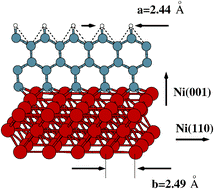Graphene—Ni (001) interface study
Abstract
The interfacial properties for a

a Department of Physics, Wuhan University, Wuhan, Hubei, P. R. China
b Department of Materials Science and Engineering and Department of Physics, The University of Texas at Dallas, Richardson, Texas 75080, USA
c Division of WCU Multiscale Mechanical Design, School of Mechanical and Aerospace Engineering, Seoul National University, Seoul 151-744, Republic of Korea
d College of Physics, Nankai University, Tianjin, 300071, , P. R. China
The interfacial properties for a

 Please wait while we load your content...
Something went wrong. Try again?
Please wait while we load your content...
Something went wrong. Try again?
M. Zhao, W. Xiao, H. Zhang and K. Cho, Phys. Chem. Chem. Phys., 2011, 13, 11657 DOI: 10.1039/C0CP02910F
To request permission to reproduce material from this article, please go to the Copyright Clearance Center request page.
If you are an author contributing to an RSC publication, you do not need to request permission provided correct acknowledgement is given.
If you are the author of this article, you do not need to request permission to reproduce figures and diagrams provided correct acknowledgement is given. If you want to reproduce the whole article in a third-party publication (excluding your thesis/dissertation for which permission is not required) please go to the Copyright Clearance Center request page.
Read more about how to correctly acknowledge RSC content.
 Fetching data from CrossRef.
Fetching data from CrossRef.
This may take some time to load.
Loading related content
